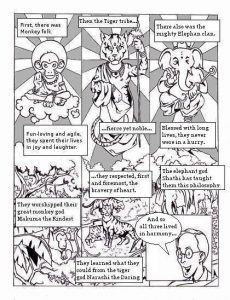We had an extremely successful comic book competition focused on religious tolerance with entries from 7 countries worldwide. More than anything else, we were very impressed by the book quality.
In this next series of blog posts, we would like to highlight some of the most exceptional competition winners.
Our international runner-up winner is Kirill Tšernov from Estonia. His beautifully written and illustrated entry depicts the importance of religious tolerance from an angle every kid can relate to- animals. His book is titled “Jungle Holy Book”.
Here is a link to the full comic book online: https://www.ezcomics.com/site/sites/all/themes/ezcomics_new/view_comics.php?viewid=163
And here is a blog post, in Kirill’s own words, about his experience writing the comic.
Sometimes our dreams take us to strange places. As far as I can remember, I’ve always wanted to be a comic book creator. But writing about religious tolerance? Who would’ve thought, indeed.
Though it’d sound great if I were to say that everything came to me in a flash of divine inspiration, in reality I spent hours upon hours just developing the initial draft. There are really no shortcuts to writing, there is only one option: get down to work. And that I did.
Coming up with a good idea is not really a brain-wrecking process. Working on that same idea, on the other hand, proves to be a herculean task. An idea is always akin to a rough diamond that needs polishing and refinement. For starters, I focused on what I personally would like to see in this kind of story. I entertained a notion that no one exactly looks forward to being preached and spoon-fed, especially when it’s done in a highbrow, matter-of-fact style, so I opted for more easy-going storytelling. Something that did not challenge directly reader’s opinions but perhaps offered a slightly different perspective. A parable seemed like an obvious choice.
As for the art, I never ever considered myself an adequate artist – and it definitely showed. But for what my art was worth, I used it to somewhat compliment the story. In his Comics and Sequential Art, Will Eisner proposed an interesting idea: instead of looking at panels separately, we should observe the page as one big panel in itself. It was a brilliant advice, so I planned my sketches and drawings accordingly: a parable was made more symbolic through the usage of symmetrical designs. Each panel now was a crucial element in the overall page layout. It also made me not lose my interest half-way through, and I cannot undescore enough how important that is in creating a comic book.
All in all, having been able to illustrate my very own story and – even better – present it to larger audience definitely made this experience worthwhile. I guess I cannot do without a moral here – in a way, I am expected to. I think the lesson is this: not all contests are about winning and earning valuable trophies. What truly is important is whether you had something to say, however little a difference you might think it all makes.
In a final analysis, I guess we all won.

